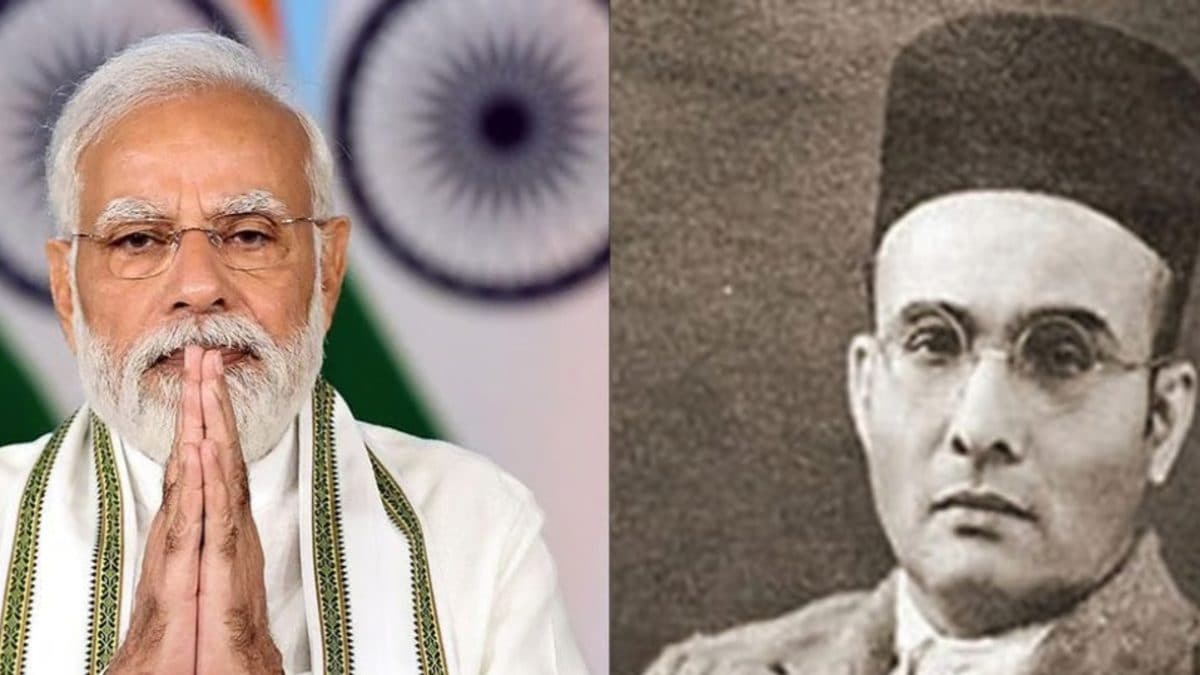Last Updated:
The decision was taken at a meeting of the executive council, the highest decision-making body of DU, in 2021. As per the minutes of this meeting, the then V-C took the final call on the name
PM Narendra Modi virtually laid the foundation stone for the two Veer Savarkar College in Delhi’s Najafgarh on January 3. (Image: X/File)
The recent controversy over the naming of an upcoming DU college after Hindutva ideologue VD Savarkar – often a divisive political figure – finds its roots in a “majority decision” taken by the varsity’s executive council in 2021.
Some have claimed that the decision was taken “with no or little discussion over the naming process”, and that teachers had even protested against it. But, the acting V-C at the time denied this and said there were no protests and, if there was any dissent, it was not recorded in the minutes of the meeting.
On January 3, when Prime Minister Narendra Modi was to lay the foundation stone of the Veer Savarkar College in West Delhi’s Najafgarh, the National Students Union of India (NSUI) – the Congress-backed student political wing – demanded that he must consider renaming the college after former PM Manmohan Singh, who died last month.
This sparked a wide debate among political parties as well as on social media circles. Let’s take a look at how it came to be named so.
ALSO READ | BJP’s Savvy Move On Savarkar Ratchets Up Hindutva Rhetoric In Delhi Polls
WHO TOOK THE FINAL CALL?
In August 2021, the executive council – the highest decision-making body of the Delhi University (DU) – in a meeting proposed to name the college in Najafgarh after Savarkar among other suggestions. The vice-chancellor (V-C) took the final call, as per the minutes of the meeting.
Back then, PC Joshi was the acting V-C of DU. The council noted that the Delhi government allotted land measuring 16.35 acres at Roshanpura in Najafgarh and 40 bighas at Bhati Kalan in Fatehpur Beri of South Delhi to DU.
“On these pieces of land, University has decided to set up facilitation centers to cater to the needs and requirements of students staying in far-flung areas of Delhi and NCR (National Capital Region) as the first step towards opening a full-fledged college. Through these facilitation centres, examination and admission related facilities will be extended to students,” read the minutes of the meeting.
The minutes further stated that the council resolved that the names of these colleges/centres may be after “Sushma Swaraj, Swami Vivekananda, Veer Savarkar, Sardar Patel”. It was also suggested that the names of Atal Bihari Vajpayee, Savitribai Phule, Arun Jaitley, Choudhary Brahm Prakash, CD Deshmukh and Prof Amartya Sen should be included.
“After general discussion/suggestions, the council resolved that the vice-chancellor be authorised to finalise the name,” the minutes said.
‘WITHOUT MUCH DISCUSSION’
Seema Das, who teaches political science at Hindu College and was a council member in 2021, said the decision on the name was taken by a majority and “without much discussion”. Two members dissented over the point that preference for the name of the college must be given to educationists, which was not the case here.
Das, who is also a member of the AAP’s teachers’ wing, Academics for Action and Development Teacher’s Association (AADTA), said they had also registered a protest against the decision.
“Veer Savarkar, the name was floated and decided upon, without any discussion. We had dissented and even protested the decision since we were of the view that within DU, a college’s name should be one that is above all political ideologies. Moreover, since it’s an educational institution, the name should preferably be on an educationist, who has contributed to higher education in a significant way,” Das said.
But, Joshi, who was the acting V-C at the time and had the final word on the name, told News18 that he did not distinctly remember any protest and, “if there was even a dissent, it was not recorded in the minutes of the meeting”.
He said at the council meeting, four names were agreed upon and given an in-principle approval, which included Sushma Swaraj, Arun Jaitley, Swami Vivekananda and Veer Savarkar.
“My idea was that there was a lot of university land lying unused in east, west and south Delhi. I got all boundaries made and decided on creating small structures like facilitation centres for admission-related formalities and official work for students living in far-flung areas, but we didn’t have any money to come up with it. At that time, several names had come up for discussion, of which four were agreed upon,” said Joshi, who has retired now.
Prof Abha D Habib, secretary of the Democratic Teacher’s Front, said even though names such as those of Prof Amartya Sen were suggested, the majority decided in favour of Savarkar.
“First of all, Savarkar has been a controversial and a rather divisive figure. He was not a national leader or a reformer. An educational institution’s name should be ideally on thinkers, who are inspiring figures,” she said.
WHAT IS THE PROJECT?
With a built-up area of 18,816.56 sq m and at an estimated cost of Rs 140 crore, the college will include 24 classrooms, eight tutorial rooms, 49 faculty rooms, department libraries, conference rooms, and a canteen.
At present, DU has the north and south campuses while there are some colleges in east and west Delhi. Along with this college in Najafgarh, Modi also laid the foundation stones for two other projects – the East and West campuses – which will offer students living on the outskirts more opportunities and access to study in DU colleges.







